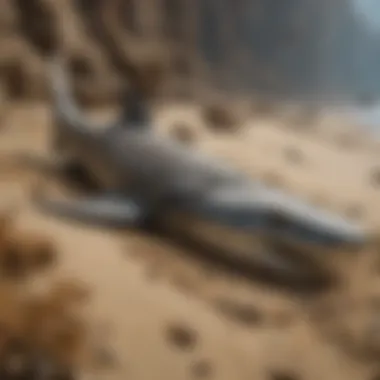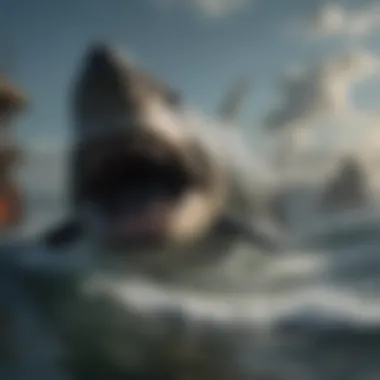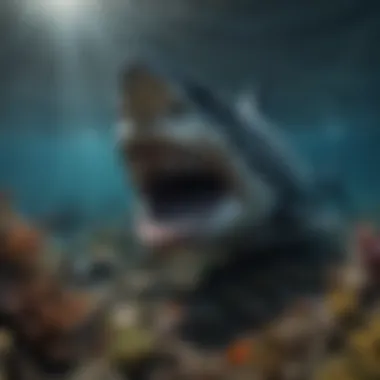Unveiling the Mystery: Megalodon - The Enigmatic Giant of the Deep Seas


Rock and Fossil Identification
Moving into the realm of rock and fossil identification in the context of the majestic megalodon, one must first grasp the intricate nature of these ancient remains. The types of rocks and fossils that potentially hold clues to the existence of this prehistoric behemoth vary widely, ranging from sedimentary to metamorphic formations. To embark on the journey of uncovering such fossils, enthusiasts need to be aware of the unique characteristics to look for, such as imprints of sharp serrated teeth characteristic of the great megalodon. Utilizing tools for identification is imperative, with magnifying glasses and brushes being indispensable for delicate excavation work.
Collecting Tips and Techniques
Delving deeper into the world of megalodon studies entails understanding the best practices for collecting fossils. Enthusiasts are advised to traverse coastal regions rich in sedimentary deposits for prime megalodon fossil hunting grounds. Locating prime collecting sites involves meticulous research and collaboration with local experts to pinpoint high-yield areas for excavation. When it comes to extracting specimens, it is crucial to employ safe and non-invasive techniques, ensuring that each fossil is carefully removed from its resting place without damage.
Preservation and Display
The aspect of preservation and display in the megalodon saga is of utmost importance to ensure the longevity and appreciation of these ancient artifacts. Implementing various techniques for preserving rocks and fossils is crucial in maintaining their integrity for future generations. Proper storage methods involving climate control and minimal exposure to light are vital for conserving the pristine condition of megalodon fossils. On the creative front, enthusiasts can explore innovative display ideas, such as shadow box arrangements or interactive museum exhibits, to showcase the grandeur of these prehistoric giants.
Geological Insights
In the pursuit of unlocking the mysteries surrounding the megalodon, a keen focus on geological insights unveils an array of fascinating revelations. Exploring the geological formations and processes that influenced the habitats of these ancient creatures sheds light on the environmental conditions that prevailed during their era. Delving into the historical significance of rocks and fossils associated with the megalodon offers a unique perspective on the interconnectedness of prehistoric life forms. Noteworthy discoveries in the field serve as testament to the tireless efforts of paleontologists and enthusiasts, unearthing rare pieces of the megalodon puzzle.
Introduction to Megalodon
In the realm of paleontology, the concept of Megalodon serves as a captivating enigma, shrouded in mystery and allure. This section sets the stage for a profound exploration of the prehistoric giant that once ruled the deep seas with its formidable presence. By delving into the origins and significance of Megalodon, readers will embark on a journey that unravels both the scientific intrigue and the cultural fascination surrounding this apex predator from the bygone era.
Defining Megalodon
Origins of the Name
The etymology of the term 'Megalodon' is a subject of profound interest, standing as a testament to the colossal nature of this ancient creature. By dissecting the roots and linguistic nuances of its nomenclature, we unearth a deeper understanding of the perceived characteristics and scale of Megalodon in popular imagination. This specific exploration of the name's origins not only sheds light on its lexical dimensions but also underscores its evocative power in evoking the sheer magnitude and enigmatic allure of this prehistoric behemoth.
Taxonomical Classification


Within the domain of taxonomical classification, Megalodon holds a distinct placement that underscores its evolutionary connections and divergences from contemporary marine species. By meticulously examining its taxonomic categorization, we gain insights into the biological relationships and adaptive features that defined Megalodon's position in the ancient marine ecosystem. This analysis not only enriches our understanding of its taxonomic lineage but also provides a framework to decipher the evolutionary adaptations that contributed to the dominance of this oceanic giant.
Size and Physical Characteristics
Comparative Analysis with Great White Sharks
A comparative analysis with Great White Sharks unveils striking parallels and deviations in the morphological traits and behavioral patterns of these apex predators. By juxtaposing the size, dental morphology, and ecological roles of Megalodon and Great Whites, we illuminate the evolutionary trajectories that shaped their respective predatory strategies and ecological niches. This comparative lens not only elucidates the distinct evolutionary paths of these maritime predators but also underscores the intriguing dynamics of interspecies competition and coexistence in ancient seas.
Jaw Structure and Bite Force
The jaw structure and bite force of Megalodon stand as hallmark features of its predatory might and physiological prowess. Through an exploration of its jaw anatomy and biomechanical capabilities, we uncover the biomechanical adaptations that endowed Megalodon with a formidable biting force capable of decimating large marine prey. This insightful analysis not only underscores the unparalleled predatory efficiency of Megalodon's hunting tactics but also highlights the biomechanical innovations that set it apart as a preeminent apex predator of the deep seas.
Habitat and Distribution
Paleoenvironmental Reconstructions
Tracing the paleoenvironmental reconstructions of Megalodon unveils a vivid tapestry of ancient marine landscapes and ecological interactions that shaped its evolutionary trajectory. By reconstructing the environmental conditions and geographic ranges inhabited by Megalodon, we gain a glimpse into the paleoecological dynamics that influenced its distribution and dietary preferences. This investigation not only offers a window into the prehistoric habitats of Megalodon but also illustrates the intricate interplay between environmental factors and evolutionary adaptations in molding the ecological niche of this iconic marine predator.
Global Presence
The global presence of Megalodon echoes its widespread distribution across the ancient oceans, symbolizing its role as a cosmopolitan apex predator of unparalleled scale. By exploring the fossil records and paleontological evidence from diverse geographical regions, we unravel the spatial extent of Megalodon's dominance in marine ecosystems worldwide. This comprehensive overview not only underscores the global reach of Megalodon's evolutionary success but also illuminates the interconnected nature of ancient marine faunas and the transcendent influence of this colossal predator on prehistoric underwater realms.
Scientific Evidence of Megalodon's Existence
In the intricate tapestry of paleontology, the scientific evidence of Megalodon's existence stands as a beacon of understanding amidst the murky depths of the past. This section aims to unravel the enigmatic shroud veiling this colossal predator by delving into the fossils and remnants left behind. Through meticulous examination of teeth, skeletal remains, and fossilized bite marks, researchers piece together the puzzle of Megalodon's existence with scientific precision.
Fossil Discoveries
Teeth and Skeletal Remains


When exploring the annals of prehistoric creatures, the significance of teeth and skeletal remains becomes paramount in unraveling the mysteries of Megalodon. These fossilized relics offer a tangible link to the past, providing insights into the formidable jaws and sheer magnitude of this ancient giant. The serrated edges of Megalodon teeth hint at a carnivorous diet and a predatory lifestyle, showcasing adaptations for hunting in the primeval seas.
Fossilized Bite Marks
Among the telltale signs preserved in the fossil record are the fossilized bite marks, etched into marine flora and fauna by the colossal jaws of Megalodon. These imprints offer a glimpse into the feeding behavior and interactions of this apex predator, painting a vivid picture of its ecological role in ancient oceanic ecosystems. The size and morphology of these markings bear testimony to the immense power and ferocity woven into the fabric of Megalodon's existence.
Paleoecological Insights
Feeding Behavior and Prey Preferences
Delving into the realm of paleoecology unveils a rich tapestry of Megalodon's feeding behavior and prey preferences. By scrutinizing the patterns of tooth wear and diet-related isotopes in fossilized teeth, scientists unravel the dietary choices and ecological niche of this prehistoric behemoth. Understanding the interplay between Megalodon's physiology and environmental factors sheds light on its evolutionary adaptations and survival strategies in ancient seas.
Interactions with Prehistoric Marine Life
Exploring the interactions of Megalodon with prehistoric marine life provides a captivating narrative of trophic dynamics and ecological relationships. Fossil evidence of interspecies interactions and predator-prey dynamics unveils a complex web of coexistence and competition in primordial oceans. By studying the coevolutionary arms race between Megalodon and its aquatic counterparts, researchers glean insights into the ecological impacts of this colossal predator on ancient marine ecosystems.
The Extinction of Megalodon
The Extinction of Megalodon delves into the pivotal event that led to the disappearance of this enigmatic giant from the deep seas. Understanding the extinction of Megalodon is vital in unraveling the mysteries surrounding its presence and absence. By exploring the theories and speculations related to this event, we can glimpse into the ancient past and comprehend the complex interplay of factors that shaped the fate of this magnificent creature. The topic sheds light on the interconnectedness of species survival and the impact of environmental changes over time, offering a window into the evolutionary history of marine predators.
Theories and Speculations
Impact of Climate Change
The Impact of Climate Change on the extinction of Megalodon underscores the role of environmental shifts in shaping ecosystems. The climate fluctuations of the past played a crucial role in altering ocean temperatures and sea levels, impacting the availability of prey species essential for Megalodon's survival. By examining how climate change influenced the prehistoric oceans, we can draw parallels to contemporary environmental challenges and draw valuable insights for conservation efforts. Understanding the nuances of this aspect provides a deeper appreciation of the delicate balance within marine ecosystems and highlights the importance of adapting to environmental changes.
Competition and Evolutionary Pressures


The Competition and Evolutionary Pressures faced by Megalodon illuminate the fierce competition for resources in ancient seas. As apex predators, Megalodons competed with other marine species for food sources and territories, driving evolutionary adaptations and shaping the marine ecosystem. Exploring the evolutionary pressures that Megalodon endured offers a glimpse into the dynamic forces that govern species interactions and adaptation over time. By unraveling the complex web of competition and evolution, we can unravel the significance of these pressures in the context of Megalodon's extinction, providing valuable insights into the interconnected nature of species survival and evolution.
Legacy and Cultural Significance
Mythological Representations
The Mythological Representations of Megalodon transcend scientific discourse to permeate cultural narratives worldwide. From ancient sea legends to contemporary folklore, Megalodon's mythological presence captivates the imagination and underscores the enduring fascination with this prehistoric giant. By delving into the mythological interpretations of Megalodon, we can explore how ancient cultures embraced the enigmatic nature of this creature, weaving it into their folklore and collective consciousness. The mythological representations of Megalodon offer a unique lens through which to appreciate the cultural impact of this ancient predator and its lasting legacy in human storytelling.
Pop Culture References
The Pop Culture References to Megalodon span a vast array of media and entertainment realms, reflecting its enduring popularity in modern culture. From blockbuster movies to documentaries, Megalodon's larger-than-life presence continues to capture the imagination of audiences worldwide. Exploring the pop culture references associated with Megalodon allows us to analyze how popular media has portrayed this prehistoric giant, shaping public perception and interest in paleontology. By examining the intersection of science and entertainment in pop culture references, we can appreciate how Megalodon's legacy transcends scientific discovery to become a cultural icon, inspiring further curiosity and exploration into the mysteries of the deep seas.
Current Perspectives and Ongoing Research
The section on Current Perspectives and Ongoing Research within this article serves as a crucial component in shedding light on the ongoing investigations and advancements in our understanding of the megalodon. It provides a gateway to explore the cutting-edge developments and insights that are shaping the field of paleontology today. By delving into the latest methodologies and discoveries, readers are presented with a fresh lens through which to view this enigmatic creature of the deep seas.
Advancements in Paleontological Techniques
Genetic Analysis of Fossil Samples
In the realm of Genetic Analysis of Fossil Samples, a pivotal aspect emerges that greatly influences our comprehension of prehistoric organisms like the megalodon. Through the study of ancient DNA extracted from fossil remains, scientists can unravel genetic clues that offer unprecedented insights into the evolutionary history and relationships of these ancient marine predators. The remarkable feature of Genetic Analysis of Fossil Samples lies in its ability to uncover hidden genetic details that enhance our understanding of species divergence and adaptation over time. This technique's unique advantage lies in its capacity to bridge gaps in the fossil record, allowing for a more holistic interpretation of past ecosystems. Despite its promising contributions, Genetic Analysis of Fossil Samples also faces challenges such as sample contamination and degradation, which must be carefully managed to ensure the reliability of the obtained data.
Digital Reconstruction Technologies
Within the domain of Digital Reconstruction Technologies, a revolutionary tool emerges that revolutionizes our capacity to visually recreate and analyze extinct organisms such as the megalodon. By utilizing advanced software and imaging techniques, researchers can digitally reconstruct the morphology and behaviors of prehistoric creatures based on fossil evidence. The key characteristic of Digital Reconstruction Technologies lies in their ability to generate scientifically accurate virtual models that offer profound insights into the anatomical features and ecological roles of ancient species. This technology's unique feature lies in its capacity to simulate various environmental scenarios, providing a glimpse into the past habitats and behaviors of these marine giants. While Digital Reconstruction Technologies offer unparalleled visualization capabilities, they also present challenges in accurately interpreting incomplete or fragmented fossil data, necessitating a blend of artistic interpretation and scientific rigor.
Exploration of Deep-Sea Ecosystems
Unraveling Marine Biodiversity
The exploration of Unraveling Marine Biodiversity unveils a critical aspect of understanding the intricate web of life within deep-sea ecosystems, including the interaction of apex predators like the megalodon with their environment. By studying the diversity and distribution of marine species across different depths and regions, researchers gain valuable insights into the ecological dynamics that shaped prehistoric oceans. The key characteristic of Unraveling Marine Biodiversity lies in its capacity to uncover hidden species associations and evolutionary patterns, shedding light on the ecological roles and adaptations of ancient marine organisms. This aspect's unique feature lies in its potential to inform conservation efforts by identifying keystone species and vulnerable ecosystems that require protection. While exploring Unraveling Marine Biodiversity presents a wealth of data, challenges such as deep-sea access limitations and species identification complexities demand interdisciplinary collaboration for accurate interpretations and conservation strategies.
Implications for Conservation Efforts
Delving into Implications for Conservation Efforts reveals a pivotal consideration regarding the preservation of deep-sea ecosystems and the organisms that inhabit them, including those that roamed the oceans during the megalodon's reign. By assessing the impact of human activities on marine biodiversity and habitats, conservationists can develop strategies to mitigate threats and safeguard vulnerable species. The key characteristic of Implications for Conservation Efforts lies in its ability to bridge scientific research with environmental advocacy, translating knowledge into actionable measures for marine conservation. This aspect's unique feature lies in its potential to raise awareness about the interconnectedness of marine ecosystems and human activities, fostering a sense of stewardship towards the preservation of our oceans. While addressing Implications for Conservation Efforts presents significant opportunities for conservation success, challenges such as regulatory obstacles and global collaboration gaps require concerted efforts from policymakers, researchers, and the public to drive meaningful change.







